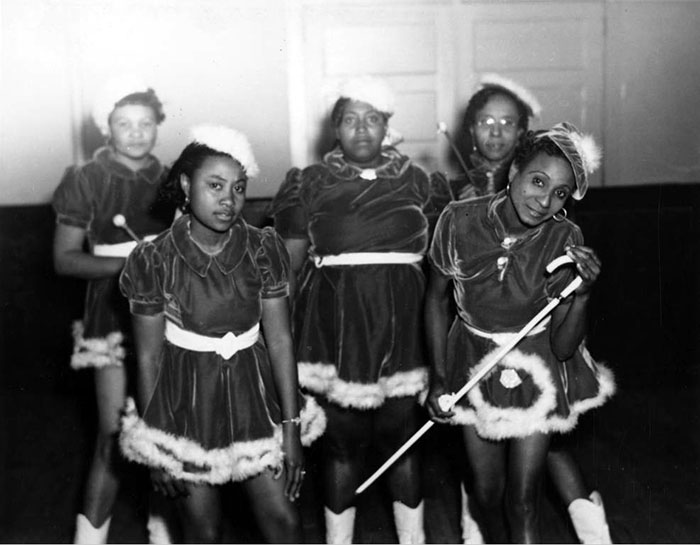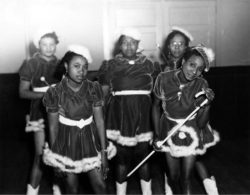Baby Dolls
The Baby Dolls were one of the first women's street masking groups in the United States. The practice continues today as a living legacy.

Courtesy of State Library of Louisiana.
New Orleans women costumed as Baby Dolls for the Mardi Gras celebration in 1942. The photographer is unknown.
Baby Dolls are groups of women and men who costume in frilly bonnets and short skirts with bloomers on Mardi Gras day in New Orleans. These distinctively dressed revelers sing ribald songs and dance suggestively as they parade around their neighborhoods, and they have become as integral to the city’s African American celebration of Carnival as have Mardi Gras Indians, Skull and Bone gangs, and the annual Zulu Social Aid and Pleasure Club parade.
Baby Dolls are thought to have emerged around 1912 among prostitutes in the segregated red-light district of New Orleans known as Uptown or Black Storyville. In 1897 the street boundaries established by City Council Ordinance 13485 for this district were Perdido, Gravier, Locust, and Franklin Streets, a few blocks away from the notorious original Storyville on the colloquial “downtown” side of New Orleans. The downtown district was solely reserved for white patrons, though the prostitutes were either white or of lighter-skinned mixed racial ethnicity. Elaborately built and expensively furnished brothels that were advertised in Blue Books and frequented by a high-paying clientele largely defined the downtown Storyville, but it also contained more modest houses of prostitution and single-room “cribs.” In Black Storyville, working-class black and white men pursued the vices of gambling, drinking, and buying the sexual services of black women.
While the inhabitants of Black Storyville faced an existence fraught with police harassment, theft, violence, and poverty, their milieu was rich in the African American vernacular culture of music, dance, costuming, and parading. Groups of friends or work associates regularly formed social aid and pleasure clubs whereby members supported each other in hard times and planned recreational and leisure events to have a good time. It was during these good times that they could show off their talents for dancing and dressing lavishly—most commonly in street parades accompanied by brass bands. It was also a social climate in which musicians, performers, and informal clubs enjoyed competing against each other in terms of costume, musical virtuosity, and dancing ability. The Baby Doll masking tradition emerged from this cultural mix. They were one of the first women’s street masking groups in the United States; the practice continues today, though largely removed from its risqué origins.
Million Dollar Baby Dolls
The exact origins of the Baby Dolls are not known. Interviews conducted in 1940 by Robert McKinney, a field researcher with the federally funded Louisiana Writer’s Project, provide a source of the tradition’s roots. One oral history attributes the start to a rivalry between a group of women who worked in Black Storyville and those who worked in Storyville. The rivalry stemmed from differences among black women in terms of their skin color, religion, and relative privilege of working in a legal district (Storyville) versus those who worked in the Black district, whose legality was held in abeyance, whose skin color may have been darker, and whose religion may not have been steeped in Creole Catholicism.
Black Storyville’s women used the culturally sanctioned practice of settling scores through street-based performances. The group planned to mask for that year’s Carnival as “baby dolls,” adopting the name of their practice from the moniker male pimps gave them. This group—led by Beatrice Hill, Leona Tate, and Althea Brown—decided that each masked woman should have fifty dollars in her garter and be ready to confront her rivals. After parading through the city as a walking group and entertaining Mardi Gras revelers with their bawdy dancing and ribald songs, the women met their opponents in Sam Bonart Park. They challenged their competitors in both costuming and display of such masculine-appropriated behavior as smoking cigars, boastful confrontations, and throwing money at male onlookers. They called themselves the “Million-Dollar Baby Dolls” and repeated their performances each Carnival thereafter. They also sponsored dances with music performed by the hot jazz bands of the day. In the same tradition as the Mardi Gras Indians, the Baby Dolls costumed again on the night of St. Joseph’s feast, March 19, which during the Lenten season has served as an unofficial respite, when celebrations are permitted. Clara Belle offered another view of the practice’s origins: she claims that she always dressed liked a Baby Doll and had success in attracting attention on Mardi Gras day. Other women admired her and joined her in imitation. Whatever the Baby Dolls’s origins, these women of the Jazz Age sought sexual autonomy, freedom from domestic responsibilities, uninhibited good times, and the ability to define themselves according to their own values.
Spread and Changes in the Tradition
Over time, after the legal vice districts in New Orleans were closed and prostitution outlawed in the late 1910s, women who were not involved in the sex industry imitated the risqué costuming and behavior of those who were—although those who chose to join in such public displays were frowned upon by the more pious classes of society. The practice of Baby Doll masking spread among the black population of New Orleans and most notably in the Tremé neighborhood. Alma and Walter Batiste founded a group called the Golden Slipper Social and Pleasure Club. In the early part of Mardi Gras Day, the group cavorted as “the dirty dozen” and wore comical costumes of a suggestive nature. Later in the day, the Golden Slippers changed attire. Women masked as Baby Dolls and the men accompanied them as part of a kazoo band. Octave and Louise Phillips led the Gold Digger Social and Pleasure Club. Male participation in these groups varied. Some wore pants and shirts made of satin and top hats or derbies; others wore police uniforms, satin costumes, or even Baby Doll dresses. The custom began to decline around mid-century as the participants aged and the tradition waned in popularity. The Baby Dolls’s link to the disreputable red-light districts continued to make many feel ambivalent or even embarrassed in the age of civil rights and black empowerment. One group that retained their family tradition in spite of social change was the Happy House Social and Pleasure Club, headed by siblings Miriam and Lionel Batiste, and their 6th Ward Original Dirty Dozen Kazoo Band.
A Thriving Tradition
The Batiste siblings have served as a bridge between the old generation and the current resurgence of Baby Doll maskers. The Batistes taught a younger generation how to make the dresses, bonnets, and bloomers, and they demonstrated the joy of performing before revelers. Current groups include the Ernie K-Doe Baby Dolls, cofounded by Antoinette K-Doe, Eva Perry, and Jeannie Thomas; the Gold Digger Baby Dolls, founded by Merline Kimble and Lois Nelson; The New Orleans Society of Dance’s Baby Doll Ladies, founded by Millissia White; the Tremé Million-Dollar Baby Dolls, founded by Reza “Cinnamon Black” Wilson-Bazile; the Golden Eagle Baby Dolls, founded by Joseph Pierre “Monk” Boudreaux; and Denise Trepangier’s 504 Eloquent Baby Dolls. In 2013 the Baby Doll tradition was the subject of a major installation at the Presbytere unit of the Louisiana State Museum as part of the museum’s permanent display on the history of Carnival in Louisiana.
